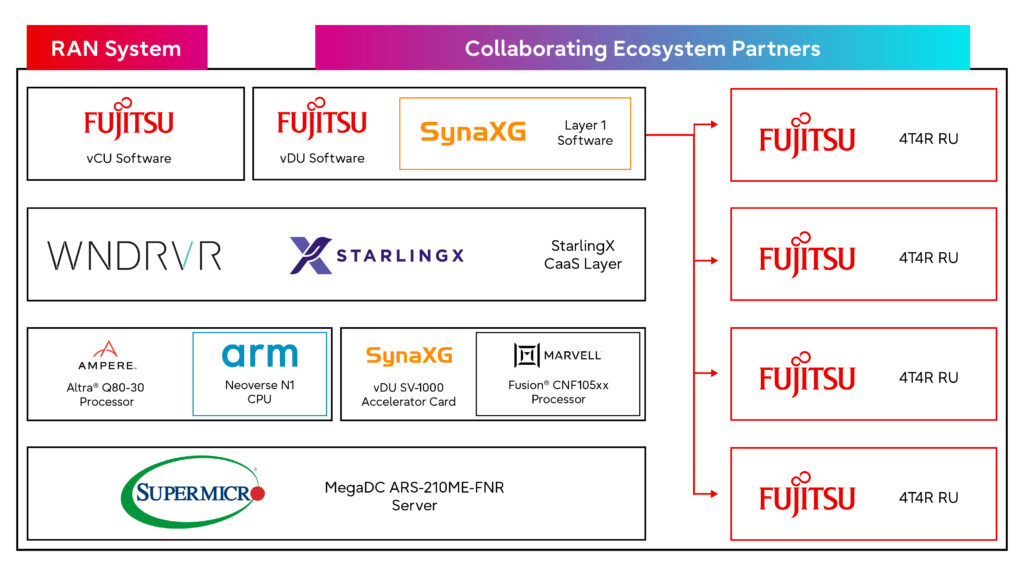
A unified approach of network virtualization from Open RAN ecosystem partners
In the rapidly evolving landscape of wireless communications, the synergy of hardware and software plays an increasingly pivotal role in shaping the future of innovation. One key enabler of this collaboration is network virtualization, a transformative approach that strategically separates hardware from software through the process of disaggregation. This blog delves into how network virtualization facilitates collaboration between companies specializing in different domains by highlighting a recent use case from Fujitsu, Wind River, SynaXG, Arm, Supermicro, and Ampere®.
The foundation of multivendor collaboration is network virtualization and disaggregation
At the core of this collaborative success story lies the concept of disaggregation. Traditionally, telecom networks were monolithic, tightly integrated systems where hardware and software were inseparable. Network virtualization disrupted this paradigm by decoupling hardware and software. This not only lowers Total Cost of Ownership (TCO) by leveraging commercial off-the-shelf hardware and the option to scale computing resources with demand, but it also allows for specialized contributions from different vendors. This shift empowers operators to embrace cloud-native architectures, which drives agility, scalability, and economies of scale.
Ambition to innovate
Together the partner companies (Fujitsu, Wind River, SynaXG, Arm, Supermicro, and Ampere) set out to collaborate on an improved virtual Distributed Unit (vDU) with the goal of lowering costs and improving energy efficiency. The Ampere Altra® family of multibit processors are powered by the Arm Neoverse cores and it is designed to meet the demands of modern cloud-native computing environments. Along with SynaXG’s 4G and 5G carrier grade accelerator card, the collaboration introduced high-performance, scalable, and power-efficient computing solutions. Supermicro MegaDC building block solutions provide modular servers that are optimized for different application workloads. Fujitsu’s expertise in both open networking and RAN software combined with Ampere’s innovative architecture based on the power efficient Arm Neoverse cores paves the way for transformative advancements in telecommunications. This collaboration benefits from the distinct strengths each company brings to the table.
Challenges of integration and rework
Historically, collaboration between vendors often leads to extensive rework, requiring intricate integration efforts to make disparate hardware and software components work harmoniously. This challenge posed a significant barrier to achieving efficiency, as the intricate dance of aligning different components can result in delays and increased costs.
Abstracting complexity for seamless collaboration
Wind River became a key player in the success of the collaboration to overcome the integration challenges. Wind River Studio supports a Container as a Service (CaaS) cloud platform, based on the StarlingX project. This is a game-changer by addressing the integration challenges through abstraction. By encapsulating software components into containers, CaaS provides a standardized environment, shielding the intricacies of the underlying hardware. This abstraction significantly reduces the complexities associated with integrating diverse components.
Wind River’s CaaS layer became the bridge that facilitated collaboration between Fujitsu’s wireless software expertise with Arm and Ampere’s processing prowess. Studio Cloud Platform provided a standardized environment where software components run consistently across different hardware infrastructures. This abstraction layer ensures that each vendor can focus on their specialized domains without the burden of extensive integration efforts, accelerating the development and deployment of innovative solutions. This standardization eliminates the need for extensive rework each time two vendors collaborate, enabling faster time-to-market for innovative solutions.
Fujitsu’s wireless software expertise meets hardware innovation
Fujitsu’s leveraged Wind River’s CaaS platform to streamline the collaboration with Arm. Fujitsu, the leader in Open vRAN market share, capitalized on this abstraction layer to port its open vRAN software to a Supermicro MegaDC ARS-210ME-FNR edge server with an Ampere-Altra Q80-30 processor based on the Arm Neoverse N1 CPU, which increases processing capacity to 80 cores while keeping energy consumption low. Combined with SynaXG’s energy efficient accelerator card, the solution gives operators more flexibility to choose the options that are best for their deployment situations. This integration is an example of the power of collaboration in a disaggregated environment.
Realizing the benefits with performance, efficiency, and sustainability
The partners integrated and tested their combined solution, which can be seen in the chart below as well as in this demo showcasing the innovative solution in action.

The collaborative efforts of the partners yield tangible benefits for operators. By harnessing the power of network virtualization and cloud-native computing, operators can achieve significant improvements in performance, efficiency, and sustainability. Specifically, the combined solution reduces power consumption by around 57%, according to Arm. This not only contributes to environmental sustainability, but also substantially reduces Operating Expenses (OpEx).
Embracing network virtualization for future collaboration
As telecommunications continue to advance, embracing network virtualization becomes imperative for unlocking new possibilities and ensuring a future-ready telecommunications landscape. Network virtualization not only facilitates collaboration between hardware and software vendors, but also allows for the creation of a multivendor ecosystem where each participant brings its unique strengths to the table.
Benefits of network virtualization:
- Specialized contributions: Network virtualization allows vendors to focus on their specialized domains, leveraging their unique strengths.
- Efficient integration and standardized environments: Abstraction layers, such as Wind River Studio Cloud Platform, reduce the complexities associated with integrating diverse components. Containerization provides standardized environments, eliminating the need for extensive rework in multivendor collaborations.
- Faster innovations: Collaboration results in groundbreaking innovations and tangible benefits such as reduced power consumption and lower costs.
A blueprint for future collaboration
The collaborative efforts of Fujitsu, SynaXG, Arm, Ampere, Supermicro, and Wind River exemplify the transformative potential of network virtualization in telecommunications. By combining expertise, innovation, and cutting-edge technologies, the partners drove forward the evolution of multivendor ecosystems, allowing operators to achieve unprecedented levels of performance, efficiency, and sustainability. As the industry continues to evolve, collaborative efforts in the Open RAN ecosystem will play a pivotal role in shaping the future of telecommunications and creating a blueprint for future industry partnerships.
The seamless integration of Fujitsu’s wireless software expertise with SynaXG, Arm, Supermicro, and Ampere’s processing innovation, facilitated by Wind River’s abstraction layer, demonstrates the power of disaggregation in driving efficiency, reducing rework, and fostering groundbreaking innovations. As telecommunications continue to evolve, this collaborative approach sets the stage for a future where specialized contributions from different vendors come together seamlessly, ultimately redefining the possibilities of what can be achieved in mobile networks. For an operator’s perspective on the power of Open RAN and the results of this multivendor collaboration, watch an interview with Vodafone’s Head of Open RAN Development, Andy Dunkin.